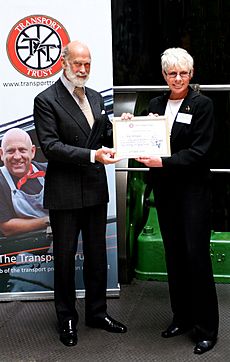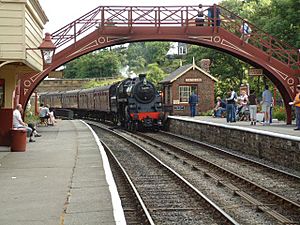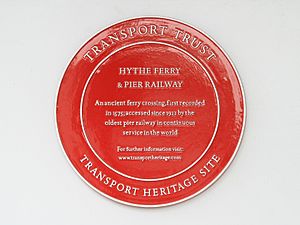National Transport Trust facts for kids
The National Transport Trust is a special group in Britain that helps save and look after old vehicles and transport history. It started in 1965 as the Transport Trust, but later changed its name to show it works all over the country.
This group acts like a central hub for everyone who loves preserving old trains, planes, buses, and boats. They give advice, help organize public events, and work to find good places to keep and fix these historic items.
Contents
What the Trust Does
The National Transport Trust is a registered charity. This means it's a non-profit organization that helps others. The Trust supports projects that fix up old vehicles and transport items. They also give helpful advice to the UK Government and other groups that work to save history, like the Heritage Lottery Fund.
Every year, the Trust gives out awards for the best restoration projects. A big part of their mission is to encourage young people to get involved in these projects. The Trust's patron, who is a supporter and role model, is Anne, Princess Royal.
Saving Transport History
The Heritage Lottery Fund asked the Transport Trust to study what challenges people face when trying to save old transport. They also wanted to know where these old items were kept and what condition they were in. This helped the Fund decide which projects needed money the most.
The study, called "Transport Heritage: An Assessment of Needs & Potential," was 145 pages long. It gave a clear picture of how well Britain's transport preservation movement was doing. It's thought that over 15 million people each year enjoy or take part in transport history activities. This makes it one of Britain's most popular hobbies! Britain has a very rich transport history, which has helped many people get involved.

It might seem surprising, but private collectors and groups have done the most to save and share old transport. Even though public museums have good collections, private groups have made a huge difference. A great example is the Avro Vulcan XH558 plane. This plane was brought back to flying condition, which was one of the hardest restoration projects ever done. People donated all the money for this project. Dr. Robert Pleming, who led the project, even won an award from the Transport Trust. He is now a Trustee for the National Transport Trust.
Saving Aircraft
Saving old aircraft in the UK really started in the 1960s. This was when many old military planes became available. A group called the British Aviation Preservation Council (BAPC) was formed in 1967 to help organize these efforts.
Over 2,500 aircraft still exist and could be saved. However, there isn't a clear plan for how to save them all. About 4% of the most important planes are kept in the best condition. But as many as 26% of the next best planes are stored outside. Also, not enough attention has been given to saving old airfield buildings.
However, in 2007, Duxford Aerodrome was named a Conservation Area. This will help protect this important site. It started as a Royal Flying Corps base in 1916 and was an active RAF base until 1961. This airfield was important during the Battle of Britain. It was also the first RAF base to get the Supermarine Spitfire plane. Today, it is home to the Imperial War Museum Duxford. This museum has the largest collection of American aircraft outside of the US.
For aircraft, the main needs are:
- Deciding which planes are most important to save.
- Moving mid-level planes into hangars (covered storage).
- Paying more attention to saving civilian aircraft.
- Teaching more people the skills needed for aircraft conservation.
Saving Buses and Coaches
There are about 4,000 old buses and coaches that people are trying to save. About 45% of these are in a known collection or museum. However, less than 30% of all preserved buses are fully restored. Most buses in museums are from the 1950s and 1960s. Only 10% are from before 1940.
Over 80% of all preserved buses are owned by private individuals. These people have done most of the work to save buses, often with little help. It has been hard to decide which buses are most important to save. This is because they are spread out across the country.
For buses and coaches, the main needs are:
- Creating a list of all preserved buses to help grade them by importance.
- Finding a plan to store the most important vehicles under cover. (Right now, 50% of all preserved buses are stored outside).
- Restoring the most important vehicles.
- Creating better ways for the public to see and learn about them.
- Saving old papers, tickets, and small items that might otherwise be lost.
Saving Railways

Britain's heritage railways and museum items are a huge investment. There are over 400 miles of track, nearly 600 stations, and about 150 locations. These railways bring in over £30 million each year and carry around 9 million passengers. They are a big part of Britain's leisure industry.
Amazingly, over 1,000 steam engines still exist! But less than 20% can run at any time. This is because it costs a lot to fix them up. Also, over 700 diesel locomotives and about 150 passenger units are being preserved. There are also over 3,000 passenger carriages and 2,500 freight vehicles in various stages of being saved.
The Heritage Railway Association helps and advises heritage lines. The busiest heritage line in Britain is the North Yorkshire Moors Railway. This railway runs over 100 days a year. It uses most of the 24-mile track built by George Stephenson and opened in 1836.
For railways, the main needs are:
- A system to grade vehicles and lines. This helps focus money on the most important ones.
- Safe ways for the public to visit workshops and sheds. This makes visits more interesting.
- Covered places for restoration work and storing carriages.
- A strong effort to save electric trains.
- Support for private projects to fix up trains. This helps more trains get saved.
- Storing old records to prevent losing valuable history.
Saving Maritime Vessels
This category includes many different types of boats and ships. It relies a lot on private individuals. Only canal and inland waterway boats have a good system for saving them. This is because they are linked to the waterways.
Other boats, like fishing boats, lifeboats, and traditional river boats, are found all over the UK. Most boats are privately owned, and most can still be sailed. In museums, smaller boats are often overshadowed by larger ones. Steam-powered boats are very popular.
About 500 small boats are considered very important historically and are set aside for preservation. Many different groups manage their interests. The National Maritime Museum is trying to help coordinate these groups. The National Small Boat Register lists over 1,200 small boats (under 12 meters or 40 feet) that are rare or have historical value. The Advisory Committee for National Historic Ships keeps a list of larger historic vessels (over 10.1 meters or 33 feet) that have strong links to the UK.
For maritime vessels, the main needs are:
- A common grading system for all types of boats. This helps decide where to focus preservation efforts.
- Better preservation of the 500 small boats that are very important. This often needs only small amounts of money.
- More training in traditional boat-building and repair skills.
- Safe storage places where at-risk boats can be kept until they can be restored.
Overall Ideas
Britain has a very rich and varied transport history. Even with all the different types of transport, there are many common ideas. Strong leadership and a clear vision are very important. Groups that bring different organizations together can play a key role.
Having covered storage is also very important for old items. These items have lasted much longer than they were ever meant to. Finally, transport is best enjoyed when it is used. Many irreplaceable historical items are wearing out. Sometimes, making working copies of them can help save the originals.
Red Wheel Programme

The Trust runs a special program called the Red Wheel programme. Through this program, they create and place special Red Wheel plaques. These plaques are usually put at very important and unique transport history sites.
Over 115 Red Wheel Heritage Site plaques have been put up. The Trust welcomes suggestions for new Red Wheel plaques. They want to highlight sites that might otherwise be forgotten or not fully appreciated by the public.

